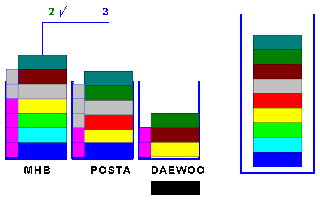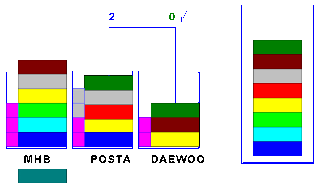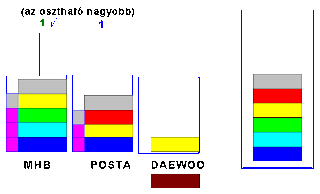Title of idea (in 2010, maybe i rewrite this...)
2.) A
new, more efficient way of intermodal(railway/highway)
transportation.
Exploit the benefits of
both railway and highway transportation and minimize their drawbacks
by optimally mixing the two methods.
Railway transportation
between two points is cheaper and more environmentally friendly, than
highway transport, however the later has the advantage of higher
flexibility.
Below we describe the case
of single delivery of goods between two locations, however the method
can be generalized to multi point delivery as well.
Suppose that a company
having only a single tractor has to deliver N trucks of goods, to a
location (B) that is M km away from the starting point (A) on road
and after that the tractor has to return to A. Suppose also that the
combined distances of nearest railway stations from points A and B is
R., while the distance between these stations over the railway is L,
and the cost of transporting a truck 1 km on road is F_road, and on
railway is F_rail. See explanatory figure 1. It is widely accepted
that F_rail <F_road.
If the company would
transport the trucks over highway it would mean N turns and 2NMF_road
cost.
Alternatively if a railway
service would exist which would involve special long carriages that
could fit in a truck, than the company could subscribe to this
service and the tractor may deliver the trucks one after another to
the nearest railway station at A’, load the railway carriages one
by one, and then the tractor is put on the train as well (together
with the last truck). Once the train arrives to the station nearest
to B than the tractor again delivers the N trucks one by one to point
B. In this case there will be N-1 turns both at A and at B, thus
altogether 2N, and the overall cost is
(2N-1)RF_road+LNF_rail+MF_road. As can be seen the mixed way of
transportation is less costly if
(2N-1)RF_road+LNF_rail+MF_road)
< 2NMF_road, or
(2N-1)RF_road+LNF_rail<(2N-1)MF_road,
R<M-LNF_rail/(2N-1)F_road.
To get a weaker but
simpler condition we can assume that N>>1, and if F_rail is
overestimated by assuming it to be the same as F_road, then the mixed
transportation will be more cost efficient if
R<M-L/2.
The above condition can be
easily probed e.g. over electronic maps of the internet for any
specific A and B location of interest.
For this service to work
buffer areas have to be developed at the railway stations where the
trucks could be accumulated until the loading of the train. Also the
special railway carriages needs to be developed (see schematic figure
1 below), where the tractor can load the truck on the carriage (with
reverse motion from the side of the carriage), and which would have
means to be locked e.g with a code key (the service provider would
supply the code) . Finally some IT background needs to be in place
for the booking of the buffer area, obtaining accurate time table
information and for the ordering of the service, (the same conditions
that are at place for the already existing types of intermodal
transportation).
The above described case
of point to point delivery can be extended to multi point scenario as
well, similar to the distribution of goods of large supermarket
chains from a central warehouse.
The main difference
between the described idea and the already existing types of
intermodal transportation like RoLa
(http://en.wikipedia.org/wiki/Rolling_highway)
is that in our case only a single tractor is involved in the
transportation. Instead of the high dead weight of many tractors on
the train it involves only a single tractor for many trucks, and also
the loading of carriages is more simple than in the case of RoLa, and
in length the two methods are comparable.
The above described way of
transportation could be beneficial for logistics companies, (even
small ones), and also for railway companies, because of the profit
coming from this service. Apart from the commercial advantage of the
involved parties, general public would also benefit by the smaller
environmental impact and smaller load on the highways.









